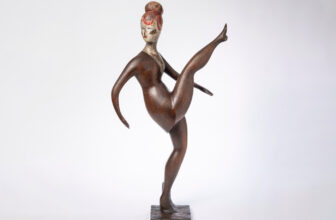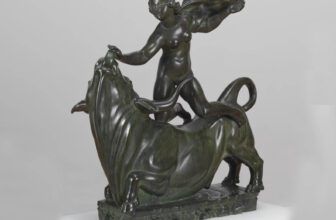
Boris Lovet Lorski Famous Art Deco Sculptures
In the world of 20th century sculpture, few names resonate with the elegance, precision, and daring modernity of Boris Lovet Lorski. Known for his extraordinary contribution to Art Deco, Lovet Lorski combined classical training with a daring modernist sensibility that transformed bronze, stone, and plaster into expressions of vitality, movement, and timeless sophistication. His works, though often understated in mainstream art history discussions, remain pivotal in the evolution of American and European sculpture, bridging traditional forms with the sleek, stylized aesthetics that defined the Art Deco era.
Early Life and Training
Boris Lovet Lorski was born in 1894 in the Russian Empire. From an early age, he demonstrated a remarkable talent for drawing and modeling, a skill that would eventually blossom into mastery over three dimensional forms. Seeking formal training, he studied at prestigious art schools in Europe, where he absorbed classical techniques in anatomy, composition, and modeling. This rigorous foundation allowed him to approach modern subjects with a disciplined eye, combining technical precision with an imaginative, almost futuristic aesthetic.
Moving to the United States in the early 1920s, Lovet Lorski became part of a vibrant artistic community that embraced both modernism and the enduring appeal of classical sculpture. The influence of European modernists, combined with the American fascination for industrial progress, urban dynamism, and the glamour of the Jazz Age, shaped the distinct voice that would come to define his career.
Signature Style: Art Deco Elegance
Lovet Lorski is best known for his Art Deco sculptures. Art Deco, emerging in the 1920s and 1930s, emphasized streamlined forms, geometric patterns, and stylized representations of the human figure. Unlike the flowing, organic lines of Art Nouveau, Art Deco celebrated symmetry, elegance, and the intersection of art and modern life. Lovet Lorski mastered this vocabulary, creating sculptures that captured both the human form and the era’s fascination with speed, modernity, and sophistication.
His work often features elongated figures, poised in graceful yet dynamic poses. Whether depicting dancers, athletes, or allegorical figures, Lovet Lorski’s sculptures convey a sense of movement and tension that seems to defy the solidity of bronze or stone. One of the hallmarks of his style is the combination of realism with abstraction, a tension between naturalistic anatomy and the stylized, almost architectural shapes characteristic of Art Deco.
Most Famous Sculptures
Several works define Boris Lovet Lorski’s reputation and continue to attract collectors, museums, and art historians alike. Among his most celebrated pieces:
The Whispering Woman (1929)
This bronze sculpture exemplifies Lovet Lorski’s ability to capture subtle emotion in a stylized form. The figure leans forward slightly, her head turned as if sharing a secret, and the geometric folds of her gown create a rhythm of lines that is both decorative and expressive.Dancer in Motion (1931)
A dynamic figure of a female dancer caught mid step, this sculpture demonstrates Lovet Lorski’s fascination with movement. The exaggerated lines of her limbs and the stylized drapery convey energy and grace, making it a quintessential Art Deco piece.The Athlete (1935)
This work celebrates human physicality and strength. The figure’s musculature is precise, yet the proportions are subtly elongated to suggest power and motion. Often cited as a masterpiece of Art Deco athletic sculpture, it embodies the era’s admiration for vigor, modernity, and progress.Animalier Works
Lovet Lorski also explored animal forms with great sensitivity. His stylized depictions of horses, lions, and birds exhibit both anatomical knowledge and a modernist abstraction that aligns them with his human figures. These works are rarer but highly prized for their unique combination of realism and Art Deco elegance.
Techniques and Materials
Boris Lovet Lorski’s sculptures reflect a meticulous approach to technique and material. He primarily worked in bronze, plaster, and stone, each chosen for its expressive potential. His bronze pieces often employed the lost wax casting method, a labor intensive process that allows for intricate detailing and precise finishes. Lovet Lorski’s mastery of this technique enabled him to create smooth, flowing surfaces and sharp, geometric edges, a duality central to his style.
For plaster and stone works, he began with detailed clay models, refining anatomical forms and geometric patterns before moving to the final material. He frequently incorporated stylized lines, planes, and curves, ensuring that every sculpture could catch light and shadow in a way that enhanced its aesthetic impact. His attention to texture, proportion, and movement remains a defining characteristic of his work.
Lovet Lorski’s influence extends beyond his individual works. He played a significant role in the American Art Deco movement, contributing sculptures for public buildings, exhibitions, and private collections. His work represents a bridge between European modernist principles and American decorative arts, helping to define a uniquely transatlantic version of Art Deco.
Collectors and historians appreciate his sculptures not only for their beauty but also for their historical significance. Lovet Lorski managed to balance artistic sophistication with accessibility, creating works that were at once modern, decorative, and emotionally resonant.
Where to Find His Sculptures
Boris Lovet Lorski’s sculptures are relatively rare in public collections, but they can be found in several prestigious institutions and private collections. Key locations include:
The Smithsonian American Art Museum: Holds select Lovet Lorski pieces, particularly smaller bronzes and animalier sculptures.
The Metropolitan Museum of Art, New York: Includes a few examples of his Art Deco works in their 20th century decorative arts collection.
Private Collections and Galleries: Many of Lovet Lorski’s works circulate among collectors of American Art Deco sculpture. Auctions occasionally bring his pieces to public attention, often fetching high prices due to rarity.
Public Monuments and Commissions: Some of his larger works and architectural sculptures are integrated into public buildings and historic sites, particularly from the 1930s.
Market Value of Boris Lovet Lorski Sculptures
The value of Lovet Lorski’s sculptures varies significantly depending on size, material, and provenance. Smaller bronze or plaster figures might sell for $10,000 to $50,000, while rare or large scale works, particularly those with verified provenance, can exceed $100,000 at auction. Collectors prize his pieces for their historical significance, stylistic elegance, and rarity, which combine to create a strong and enduring market demand.
Auction houses specializing in American Art Deco or 20th century sculpture occasionally highlight his work, emphasizing both artistic merit and investment potential. As Art Deco has seen a resurgence of interest among collectors and interior designers, Lovet Lorski’s reputation, and the value of his sculptures, continues to grow.
The Artistic Philosophy Behind His Work
Lovet Lorski approached sculpture as both a technical and philosophical pursuit. He was fascinated by the human figure, movement, and the ways in which geometry and abstraction could enhance natural forms. Unlike purely decorative artists, he infused his work with a sense of narrative and emotion, often portraying figures in moments of thought, grace, or action.
In interviews and letters, he emphasized the importance of balance: between realism and abstraction, motion and stillness, simplicity and complexity. This philosophy resonates clearly in his work, where each curve, line, and surface seems deliberately orchestrated to convey both aesthetic beauty and emotional depth.
Boris Lovet Lorski Legacy and Recognition Today
Though not as widely known as some contemporaries like Paul Manship or Demetre Chiparus, Boris Lovet Lorski occupies a distinct niche in 20th century sculpture. His works are celebrated in Art Deco retrospectives, scholarly studies, and collector circles. Museums and galleries increasingly recognize his contribution to bridging European modernism and American decorative art, ensuring that his legacy endures.
Modern collectors and interior designers also appreciate the timeless elegance of his pieces. Whether displayed in a home, gallery, or museum, Lovet Lorski’s sculptures continue to captivate with their combination of grace, movement, and geometric sophistication.
Boris Lovet Lorski represents the pinnacle of Art Deco sculpture, blending technical mastery, modernist aesthetics, and emotional resonance. From the subtle grace of The Whispering Woman to the kinetic energy of Dancer in Motion, his works are a testament to the enduring appeal of the Art Deco style and the power of sculptural expression.
His approach to materials, technique, and form, combined with a dedication to stylistic innovation, ensures that his sculptures remain not only beautiful objects but also significant historical artifacts. With works in museums, private collections, and occasional auctions, the legacy of Boris Lovet Lorski continues to enchant collectors, historians, and admirers of Art Deco around the world.
As collectors seek timeless elegance and historians trace the arc of modern sculpture, Lovet Lorski’s name resonates with authority and artistry. His sculptures, whether depicting human grace, athletic power, or stylized animal forms, continue to celebrate the aesthetic ideals of an era while transcending time, offering viewers a glimpse into a world where form, movement, and elegance converge in bronze, plaster, and stone. image/ johnraimondi




